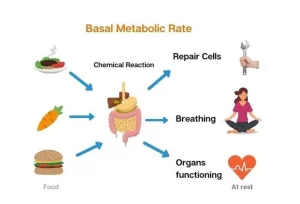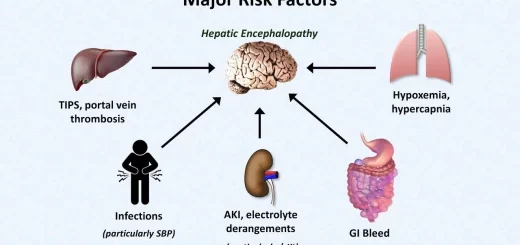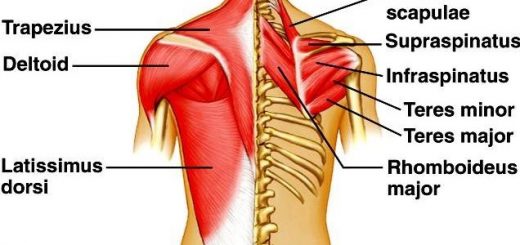Metabolism, Energy balance, Basal metabolic rate and Factors affecting respiratory exchange ratio
When carbohydrates, fats, and proteins are burned with pure oxygen, large amounts of energy are released. They are stored in the form of high-energy compounds such as adenosine triphosphate (ATP) and creatine phosphate (CP= also called phosphocreatine). ATP is the energy currency of the body and the most important high-energy compound.
Energy transfer
ATP → ADP → AMP
CP (3-8 times as abundant as ATP) → Creatine + Phosphate+ energy (13Kcal/mole)
Units used to measure heat energy
- The calorie (cal, with small c): It is the amount of heat energy necessary to raise the temperature of 1 gram of water, 1 degree, from 15 degrees centigrade to 16 degrees centigrade.
- The kilocalorie (Kcal, Calorie, with capital C). It equals 1000 cal. It is the unit commonly used in physiology and in medicine.
The energy balance
In the body, there is an energy balance between the caloric intake (in the food and drinks we consume) and the energy output (the energy we burn during different body activities) So, 3 possible states can occur:
- Positive energy balance: The energy input exceeds the energy output. Thus, the individual gains weight.
- Negative energy balance: The energy output exceeds the energy input. Thus, the individual loses weight.
- Energy equilibrium: The energy input equals the energy output. Thus, the body weight is constant.
How can we calculate the energy input?
By using the physiologic caloric value of food, which is the amount of energy liberated by oxidation of one gram of food substance in the body. It equals: 4.1Kcal/gram of carbohydrates, 4.1Kcal/gram of protein, and 9.3 Kcal/gram of fat.
The metabolic rate (energy output = energy expenditure).
Definition of the metabolic rate: It is the amount of energy liberated per unit of time. It is divided into several components including performing essential metabolic functions to keep the person alive (BMR), physical activities, processing of ingested food, and maintenance of body temperature.
The basal metabolic rate (BMR)
It is the minimal energy expenditure for the body to exist under basal conditions (activity of the central nervous system, heart, kidneys, liver) without the effect of exercise or external factors. It accounts for about 50 to 70 percent of the daily energy expenditure in most sedentary individuals. It is measured under the following basal conditions:
- Complete physical and mental rest (but no sleep).
- Post absorptive state: 12- 14 hours after the last meal.
- At a comfortable room temperature, which is from 20 to 25 degrees centigrade, for dressed persons.
Value of BMR: for a normal adult male about 40 Kcal/h/m2 ± 15%. It differs according to age, sex (mainly due to differences in the number of skeletal muscles and adipose tissue), and body surface area (determined from height and weight tables).
Measurement of the metabolic rate by indirect calorimetry
It was found that the amount of oxygen consumption per unit of time is proportionate to the energy liberated by metabolism. Thus, the metabolic rate can be calculated from the rate of oxygen consumption. The energy equivalent of oxygen is the amount of energy liberated per liter of oxygen utilized in the body. It is greater for carbohydrates than for fats or proteins. For the average mixed diet, it is about 4.82 Kcal/liter of O2 consumed.
The metabolic rate= Oxygen consumed (in liters per unit of time) X 4.82 (energy equivalent of oxygen for mixed diet in Kcal/L of oxygen consumed)
Oxygen consumption is measured with a special spirometer called “the metabolator.” Determination of the precise energy equivalent of oxygen requires data on the food being oxidized, which can be obtained from analysis of “the respiratory quotient”.
The respiratory quotient (RQ) is the ratio of the volume of CO2 produced to the volume of O2 consumed per unit of time, in the steady state. (also called respiratory exchange ratio even if the steady state is not reached).
Importance of the respiratory quotient
It indicates the type of food being utilized by the whole body and /or by individual organs. The RQ is 1 when the utilized food is carbohydrates, 0.7 when the oxidized food is fat and 0.82 when the utilized food is a protein
Clinically important points
- Immediately after a meal, the RQ is about 1. indicating that almost all the food metabolized is carbohydrates. From 8 to 10 hours later, the RQ is about 0.7, indicating that fat is the main food being utilized, after carbohydrates have been already utilized.
- The RQ of the brain is 0.97 to 0.99, indicating that carbohydrates are the main but not the only brain fuel.
- In uncontrolled diabetes mellitus and during starvation, the RQ is about 0.7 indicating that fat is metabolized.
Factors affecting the respiratory exchange ratio
Factors that increase the respiratory exchange ratio:
- Hyperventilation: due to increased volume of CO2 expired.
- Severe muscular exercise: due to the production of an extra amount of CO2 by buffering of lactic acid formed during exercise. The RQ may reach 1.5-2.
- Metabolic acidosis is during diabetic ketoacidosis and renal failure. Increased ventilation occurs as a compensatory mechanism for metabolic acidosis.
- Fevers: due to hyperventilation.
- Intake of carbohydrates.
Factors that decrease the respiratory
- Hypoventilation.
- Recovery from muscular exercise.
- Metabolic alkalosis: due to respiratory compensation by decreasing ventilation, which leads to CO2 retention.
- Uncontrolled diabetes mellitus (due to excessive fat utilization).
- Intake of fats.
You can download Science Online application on Google Play from this link: Science Online Apps on Google Play
Functions of Kidneys, Role of Kidney in glucose homeostasis, Lipid & protein metabolism
Mechanisms of cardiac reserve, cardiac work and oxygen consumption by the heart
Factors affecting cardiac output, Stroke volume, Heart rate & blood pressure




